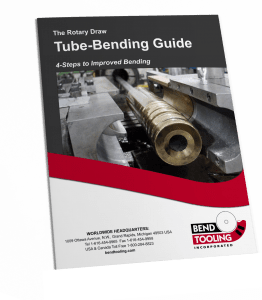The perception that aluminum is typically tougher to weld or paint than most other metals used for fabrication is pervasive, so it’s not surprising to learn that that bending aluminum tubing requires a bit more consideration than most other tubular materials.
Material Selection
Those familiar with rotary draw tube bending, or mandrel bending, can attest to the fact that aluminum-bronze mandrel and wiper tooling is a tried-and-true material for bending mild steel, stainless steel, titanium, Inconel and many other alloys. Aluminum-bronze has a relatively low friction coefficient and is commonly used in bearing application for a variety of industries. Since the mandrel and wiper die essentially serve as bearing surfaces against the tube while containing the tube’s cross section during bending, there’s no question that aluminum-bronze would be the ideal choice for most bending applications. However, if an aluminum tube is loaded over an aluminum-bronze mandrel, and furthermore sandwiched together with an aluminum-bronze wiper die, the bending process will most likely come to a screeching halt in short time.
One contributing factor to this is that aluminum happens to be a material that is prone to galling in certain situations. Galling is the microscopic transfer of material between two sliding surfaces, but although the initial transfer of material begins at the microscopic level, it’s not uncommon for quite visible and substantially large deposits to form on either contact surface.
As the name suggests, aluminum-bronze contains a significant amount of aluminum, roughly 10% in most alloys. In the bending scenario described above, we are compressing an aluminum surface against an aluminum-bronze surface, and since both materials contain aluminum molecules that will naturally attract to each other, the sliding motion creates an ideal condition for severe galling, and in this case it will occur between the inside of the tube and the mandrel, and also between the outside of the tube and the wiper-die. As the aluminum deposits increase in size, so too will the amount of friction caused by them. Eventually the material will not move as it should and tube breakage will often follow.
Since hard surfaces are resistant to galling, the best way to minimize the effects of galling are to use a polished and coated material for the mandrel and wiper tooling’s working surfaces. Hard-chrome, PVD or other similar types of coatings are recommended. Reduction in the friction associated from the galling will allow material to flow more freely into bend during the bending process. Further to this, a proper bending or drawing lubricant formulated for bending aluminum should be applied directly to the working surfaces of the mandrel and wiper die and recoated as needed throughout the production run.
Tempered for Bending
Unlike most other tubular materials, aluminum is available in a variety of tempers or heat treatment conditions. It is important to select a temper that will allow the tube to be formed without breaking. The key property to look at for determining a material’s formability is the elongation properties of that material. Most tubing may be easily bent on a relatively tight bend radius if it has an elongation rating of 20% or higher.
For example, 6061-T4 is a 6061 aluminum alloy with a T4 temper grade. A lower temper grade indicates greater elongation characteristics, so a T0 temper (25-30% elongation) is ideal for forming, whereas T6 temper grade (10% elongation) is better suited for machining. The example mentioned above, T4 typically has an elongation rating of 16%, so although it is formable, it falls below the 20% guideline, and therefore it may not be possible to achieve a tight radius bend.
These are the two most important pieces of information that have helped our customers understand their aluminum tube bending applications – no matter what size tube or what bending machine they are using. Recognizing how specific materials react differently to otherwise routine elements of an application and understanding why they react differently is the first step to finding a repeatable solution. Once a solution is adopted, it can easily be incorporated into a standard routine and no longer perceived as a tough or intimidating process.

